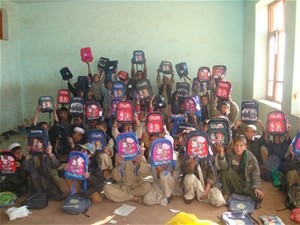
School children at the Babrak School in Paktya display their new backpacks.
USAID/LGCD
26 APRIL 2011 | PAKTYA PROVINCE, AFGHANISTAN
Children in Paktya Province face several significant challenges to getting an education. Many schools in the province lack sufficient infrastructure and are forced to hold classes wherever space can be found, such as in private homes or even outdoors. Often times, families cannot afford the costs associated with attending school, such as purchasing school supplies. This lack of service delivery can have a destabilizing effect in Afghan communities.
To address these challenges, USAID brought together the Paktya Department of Education, Provincial Development Council, and local headmasters to develop a list of schools most in need of supplies and assistance. The group identified 26 schools across eight districts to receive 11,500 school supply kits consisting of backpacks, notebooks, pencils and pencil cases. Seven schools were selected to receive a total of 43 tents. Each tent provided 40 square meters of classroom space. USAID also constructed three school boundary walls to provide safe and culturally appropriate learning environments for students.
Describing the benefits of this activity, Abdul Satar, the Headmaster of Peeran Middle School in Gardez District, said, “I am very happy with the supplies that have been provided for our school. Some students could not afford to buy backpacks to keep their books safe because of their families’ economic situations.”
Throughout the province, the lack of educational services and a secure learning environment were a significant community grievance. By actively responding to this community priority, the Department of Education is demonstrating that the government is capable of responding to community grievances and delivering public services.
USAID’s Local Governance and Community Development project works throughout Afghanistan’s most volatile provinces to improve stability through strengthened governance, and by linking local populations with local government structures to address constituents needs through service delivery.







Comment
Make a general inquiry or suggest an improvement.